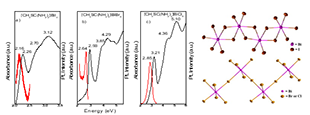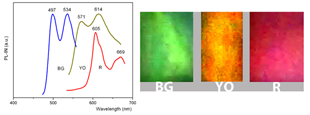Search
CLOSEOrganic-inorganic hybrid semiconductors
Dr. George A. Mousdis
Low dimensional hybrid materials
- Organic-inorganic hybrid semiconductors
- Organic Conducting and Superconducting Systems
- Spectroscopic – chemometric methods
- Metal oxide thin films
One of the most successful strategies to obtain novel functional materials is to combine the specific properties of the inorganic frameworks, such as electronic properties, and the intriguing features of the organic ligands, such as flexibility and the ability to form weak interactions.
An emerging class of these materials is the organic-inorganic hybrid halometalates. These materials are low cost and solution processable semiconducting materials. They show excellent optoelectronic properties such as high and balanced carrier mobility, long carrier diffusion length, large light absorption coefficient in the UV-vis range, nonlinear optical effects and efficient luminescence. A subclass of these materials is that with a perovskite structure. Those materials were used for the preparation of perovskite solar cells (PVSCs) that shows an excellent efficiency of more than 22%.
During the last thirty years, a large number of organic-inorganic hybrid compounds with a perovskite like structure have been prepared and studied, in our institute and in collaboration with others. Compounds of the types (CH3C6H5CH2NH3)2MX4 (M=Pb, Sn; X=I, Br, Cl) and (CH3NH3)MX3 behave as two-dimensional (2D) and three-dimensional (3D) semiconducting systems.
Compounds of the type (CH3NH3)n(C6H5CH2NH3)2Mn+1X3n+4 (n=2: bilayer; n=3: trilayer; n>3:multilayer) behave as quasi-two-dimensional (q-2D) semiconducting systems. Investigations of their optical properties showed that the excitonic optical absorption (OA) and photoluminescence (PL) bands are shifted to longer wavelengths with increasing number of layers (i.e., n).
Key Publications
Low dimensional hybrid materials
- Organic-inorganic hybrid semiconductors
- Organic Conducting and Superconducting Systems
- Spectroscopic – chemometric methods
- Metal oxide thin films



